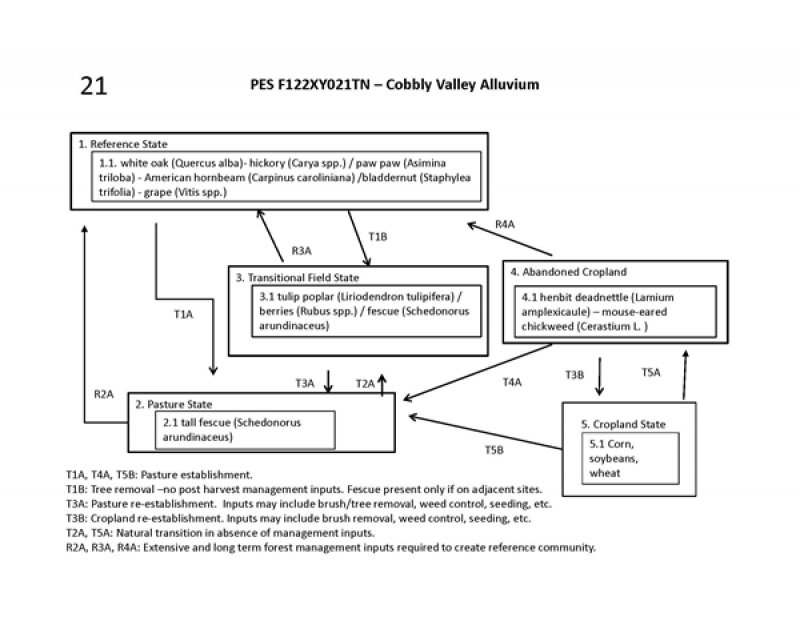
Natural Resources
Conservation Service
Ecological site F122XY021TN
Cobbly Valley Alluvium
Last updated: 5/14/2025
Accessed: 12/21/2025
General information
Provisional. A provisional ecological site description has undergone quality control and quality assurance review. It contains a working state and transition model and enough information to identify the ecological site.
MLRA notes
Major Land Resource Area (MLRA): 122X–Highland Rim and Pennyroyal
MLRA 122 is in Tennessee (47 percent), Kentucky (43 percent), Indiana (7 percent), and Alabama (3 percent). It makes up about 21,530 square miles (55,790 square kilometers).
SOILS:
Many of the soils in this MLRA are Udalfs. The moderately deep to very deep, well drained, clayey soils formed in limestone residuum. They are dominantly in rolling to steep areas of the “Outer Basin” (Mimosa, Braxton, Gladdice, and Hampshire series) and the undulating to hilly areas of the “Inner Basin” (Talbott and Bradyville series). The most agriculturally productive soils are the very deep, well drained, clayey or loamy soils that formed in alluvium and/or loess over alluvium or limestone residuum in nearly level to undulating areas (Armour, Cumberland, Harpeth, Lomond, and Maury series). The less extensive soils generally are moderately well drained to somewhat poorly drained and formed in loamy or clayey alluvium and/or residuum (Byler, Capshaw, Colbert, and Tupelo series). This MLRA has a significant acreage of Mollisols. Shallow or moderately deep, well drained, clayey Udolls (Ashwood and Barfield series) formed in limestone residuum dominantly in rolling to steep areas. Very shallow, well drained, clayey Rendolls (Gladeville series) formed in limestone residuum dominantly in undulating to rolling areas of the “Inner Basin.” Very deep, well drained or moderately well drained Udolls (Arrington, Egam, Lynnville, and Staser series) and somewhat poorly drained or poorly drained Aquolls (Agee, Godwin, and Lanton series) formed in loamy or clayey alluvium derived from limestone on flood plains. Most of the remaining soils on flood plains are moderately well drained or well drained Udepts (Lindell and Ocana series). Udults are of small extent in this area. Most are very deep, well drained, and loamy and formed in gravelly colluvium or colluvium and the underlying residuum on steep hillsides (Dellrose soils). Rock outcrops are common on uplands.
BIOLOGICAL RESOURCES:
This area supports mixed oak forest vegetation. White oak, black oak, northern red oak, and some scarlet oak are the dominant tree species. Shagbark hickory, bitternut hickory, pignut hickory, and mockernut hickory also occur. Oak, blackgum, flowering dogwood, sassafras, Virginia pine, pitch pine, and shortleaf pine grow mostly on ridgetops.
(Excerpt from United States Department of Agriculture, Natural Resources Conservation Service. 2006. Land Resource Regions and Major Land Resource Areas of the United States, the Caribbean, and the Pacific Basin. U.S. Department of Agriculture Handbook 296.)
Classification relationships
Scientific Name: Southern Interior Low Plateau Dry-Mesic Oak Forest, Unique Identifier: CES202.898
Ecological site concept
This provisional ecological site (PES) is a conceptual grouping of soil map units within a major land resource area (MLRA) based on similar soil characteristics. This PES has not been field verified and is a hypothetical description based on available existing information. Data sources include USFS reports, LANDFIRE, NatureServe Explorer, county soil surveys, and NRCS databases. ESD development is needed prior to conservation planning uses.
Ecological Dynamics:
Only two tree species can be selected for entry into the ESIS/EDIT database as dominants; however, multiple tree species may be co-dominant on these sites and it will vary depending on aspect, soil depth, seed sources, management, and disturbance history.
State 1. Reference community
Phase 1.1: Plant species dominants:
White oak (Quercus alba) - hickories (Carya spp.) / paw paw (Asimina triloba) - American hornbeam (Carpinus caroliniana) /bladdernut (Staphylea trifolia) - grape (Vitis spp.)
According to the official soil series description (OSD) for Sequatchie, most of these soils are now cleared and used for growing hay, pasture, corn, tobacco, small grains, and vegetables. Therefore, few intact old-growth, reference communities likely exist. Undisturbed, mature forest would be a mixed oak or oak-hickory forest with interspersed hardwoods such as maples, tulip poplar, pines, and cedar. In areas with more topography, the north and east slopes may show an increase in mesic, shade-tolerant, hardwood species. Understory communities would contain a diverse array of herbs and forbs.
Additional ecological information is under the community phase data section.
Similar sites
| F122XY034TN |
Well Drained Gravelly Alluvium Well Drained Gravelly Alluvium |
|---|
Table 1. Dominant plant species
| Tree |
(1) Quercus alba |
|---|---|
| Shrub |
(1) Asimina triloba |
| Herbaceous |
(1) Staphylea trifolia |
Click on box and path labels to scroll to the respective text.
